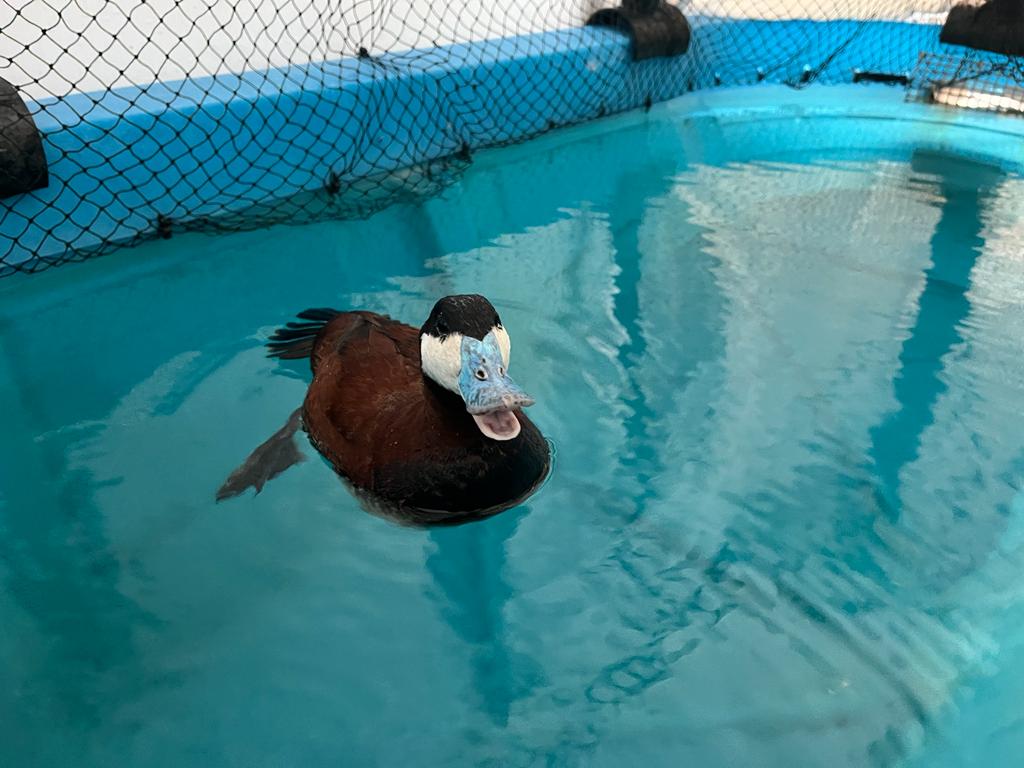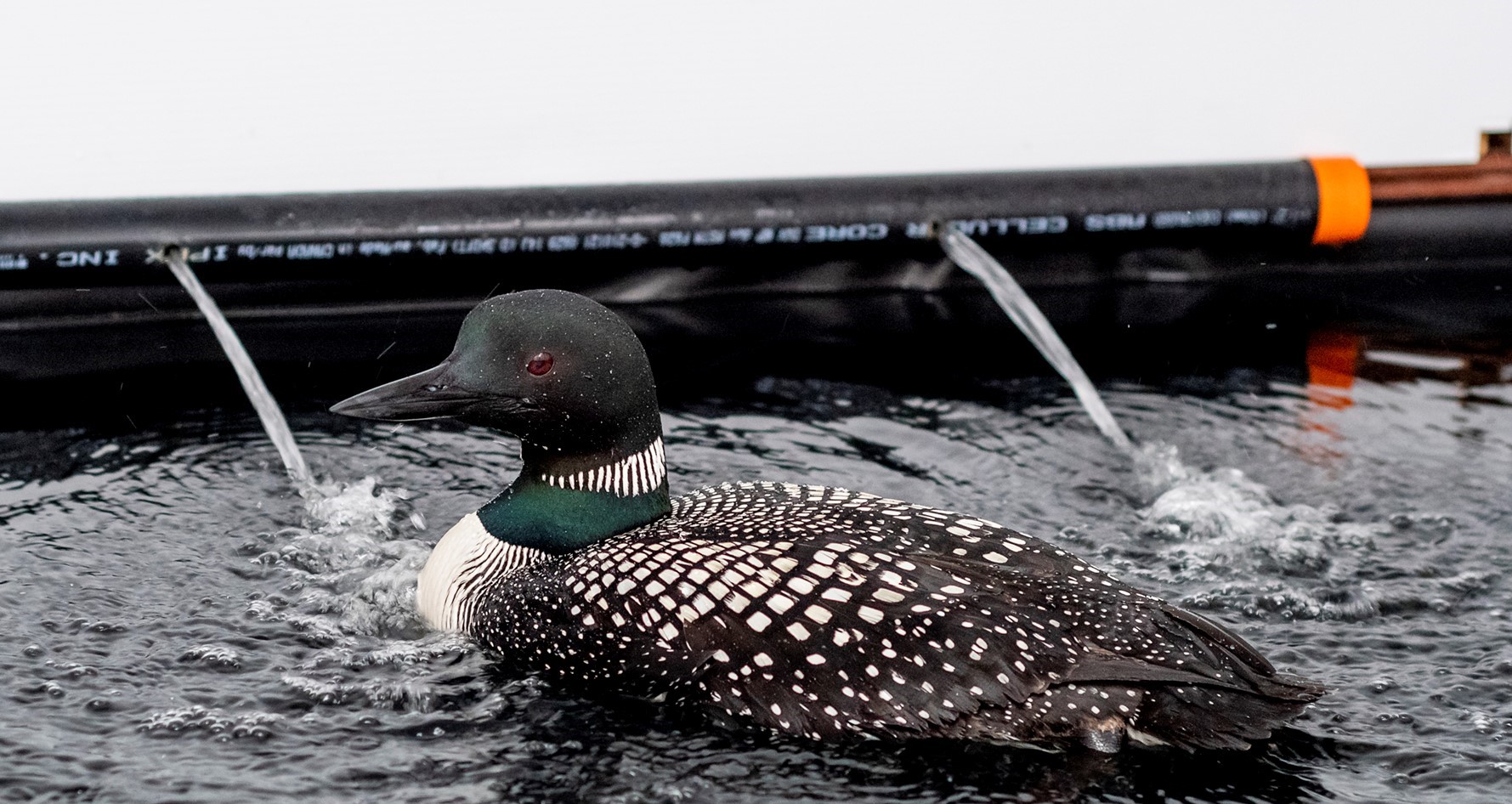by Julia Gaume
Birds have a fascinating ability that sets them apart from other animals – their natural capability to keep themselves dry when in and around water. With this, water birds are able to endure various types of terrain, from a light sprinkle to torrential downpours, while staying dry and warm. The key to their waterproofing lies within their anatomy; the unique features of their feathers and their oil-secreting gland.
Feathers
Common to almost all types of feathers are a central rachis, or feather shaft, and branches off of the rachis called barbs.1
Contour feathers are the primary feathers that are present on birds exposed commonly to the elements of water, wind and the sun. What sets these feathers apart from other types are the hooked barbicels that branch off of the barbs. These barbicels hook onto neighboring barbs in an
interlocking pattern. This pattern results in the waterproof portion of the feathers being exposed to the outside, and the fluffy, insulating portion to be kept close to the bird’s body.2
Uropygial Gland
The Uropygial gland is an essential part of the bird’s anatomy that contributes to its waterproofing. This gland, commonly referred to as the ‘oil’ or ‘preen’ gland, secretes oil near the base of the bird’s tail. When the oil is secreted, the bird spreads it around with its beak/head which constitutes a grooming method called ‘preening’.3 This secretion contains microorganisms that fight against bacteria formation and fungal infections of the skin and the surrounding feathers.4 This maintains the interlocking pattern of the hooked barbicels and supports the integrity of the barbs and barbicels on each contour feather.5 The uropygial gland, with its waterproofing qualities, is not seen in every single bird, but is best developed in birds who primarily live in the water.6 Interestingly, the uropygial gland has functions that go beyond waterproofing and its antimicrobial properties. The uropygial gland secretions in female birds have been shown to stimulate mating behaviours amongst domestic chicken.7 The chemical composition of the uropygial gland can also give you information about the bird, such as its sex, further contributing to mating.8
Disruptions
Multiple things have shown to have an inhibitory effect on bird’s natural waterproofing abilities. One major disruptor is oil. When birds are exposed to excessive amount of oils, such an in an oil spill, their feathers become matted and separate from each other. This upsets the feather’s interlocking pattern and their skin becomes directly exposed to the water, effectively reducing their buoyancy.9

Footnotes
- Study.com. “Bird Feather Types and Anatomy”. Last modified September 24, 2021. https://study.com/learn/lesson/bird-feathers-types-
parts.html#:~:text=Although%20a%20feather%20might%20look,side%20branches%20known%20as%20barbs - Birdbiology.org. “All about Feathers”. Cornell Lab of Ornithology. Last modified October 2, 2013. https://academy.allaboutbirds.org/feathers-
article/#:~:text=Contour%20feathers%20are%20what%20you,tucked%20close%20to%20the%20body. - VCAcanada.com. “Uropygial or Preening Gland in Birds”. https://vcacanada.com/know-your-pet/preening-or-uropygial-gland-in-birds
- Møller, Anders P., Erritzøe, Johannes., Tøttrup Nielsen, Jan. “Predators and microorganisms of prey: goshawks prefer prey with small uropygial glands.” Functional Ecology 24, no.3 (April 2010): 608-613. https://besjournals.onlinelibrary.wiley.com/doi/full/10.1111/j.1365-2435.2009.01671.x
- Flockingaround.com. “How do ducks and other birds stay dry?”. Last modified May 19. https://www.flockingaround.com/post/how-do-ducks-and-other-birds-stay-dry
- Bhwt.org.uk. “Uropygial Gland (Preen or Oil Gland)”. https://www.bhwt.org.uk/hen-health/learn-about-hens/uropygial-gland/
- Hirao, Atsushi., Aoyama, Masato., Sugita, Shoei. “The role of uropygial gland on sexual behaviour in domestic chicken Gallus gallus domesticus.” Behavioural Processes 80, no. 2 (February 2009): 115-120. https://pubmed.ncbi.nlm.nih.gov/19013507/
- Amo, Luisa., Avilés, Jesús M., Parejo, Deseada., et al. “Sex recognition by odour and variation in the uropygial gland secretion in starlings.” Journal of Animal Ecology, 81, no. 3 (January 2012): 605-613. https://besjournals.onlinelibrary.wiley.com/doi/10.1111/j.1365-2656.2011.01940.x
- Birdrescue.org. “How Oil Affects Birds”. https://www.birdrescue.org/our-work/research-and-innovation/how-oil-affects-birds/#:~:text=When%20oil%20sticks%20to%20a,hyperthermia%2C%20which%20results%20in%20overheating.






